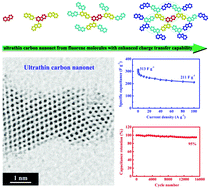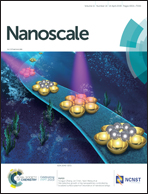From fluorene molecules to ultrathin carbon nanonets with an enhanced charge transfer capability for supercapacitors†
Abstract
It is a big challenge to synthesize ultrathin carbon nanonets with an enhanced charge transfer capability for high-performance energy storage devices. Herein, ultrathin carbon nanonets (UCNs) were successfully synthesized for the first time from fluorene, a typical aromatic molecule, by a template strategy for supercapacitors. The formation mechanism of UCNs was determined using Density Functional Theory and Materials Studio, in which the fluorene-derived radicals were assembled into UCNs in the template-confinement space with the assistance of KOH. The as-made UCNs feature interconnected high-conductivity net-like architectures with enhanced charge transfer capability, evidenced by their high capacitance, excellent rate performance and cycling stability for symmetrical supercapacitors in a KOH electrolyte. This finding may provide a significant step forward in understanding the formation mechanism of graphene-like materials from more complicated aromatic hydrocarbon molecules, and our work may draw wide attention in the fields of aromatic chemistry and carbon-based energy storage materials.

- This article is part of the themed collections: 2019 Nanoscale HOT Article Collection and International Year of the Periodic Table : Low Dimensional Carbon Systems


 Please wait while we load your content...
Please wait while we load your content...